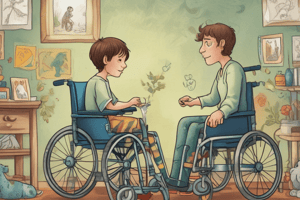Podcast
Questions and Answers
What is the primary focus of the classification of CP?
What is the primary focus of the classification of CP?
- Treatment timelines
- Types of brain lesions
- Types of cerebral palsy (correct)
- Patient demographic data
Which of the following is a common risk factor associated with cerebral palsy?
Which of the following is a common risk factor associated with cerebral palsy?
- Belonging to a minority group
- Low birth weight (correct)
- Genetic disorders
- High maternal age
What aspect is essential when considering muscle/tone pathophysiology in CP?
What aspect is essential when considering muscle/tone pathophysiology in CP?
- Assessment of muscle tone changes (correct)
- The role of cognitive development
- Impact of societal support
- Influence of nutritional factors
What might be included in orthopedic special tests for patients with CP?
What might be included in orthopedic special tests for patients with CP?
Which of the following components is crucial in the intervention strategies for CP?
Which of the following components is crucial in the intervention strategies for CP?
What is the primary function of tests and measures in the context of cerebral palsy?
What is the primary function of tests and measures in the context of cerebral palsy?
Which option best describes the role of brain lesions in cerebral palsy?
Which option best describes the role of brain lesions in cerebral palsy?
In terms of interventions for cerebral palsy, which option is NOT typically included?
In terms of interventions for cerebral palsy, which option is NOT typically included?
Which of the following classifications of cerebral palsy is primarily focused on movement patterns?
Which of the following classifications of cerebral palsy is primarily focused on movement patterns?
Which factor is least likely associated with the etiology of cerebral palsy?
Which factor is least likely associated with the etiology of cerebral palsy?
Flashcards are hidden until you start studying
Study Notes
Incidence, Etiology, Risk Factors
- Cerebral palsy (CP) is the most common motor disability in childhood
- Incidence: 2-2.5 per 1000 live births
- Etiology: Non-progressive brain lesion occurring during fetal or infant development, usually occurring before or during birth
- Risk factors: Premature birth, low birth weight, multiple births, intrauterine growth restriction, infections during pregnancy (e.g., CMV, rubella, toxoplasmosis), maternal diabetes, Rh incompatibility, genetic syndromes
Brain Lesion in CP
- Location of lesion: Periventricular leukomalacia (PVL) is a common lesion, affecting white matter surrounding the ventricles
- Types of lesions:
- PVL: Affects white matter around ventricles, leading to damage to nerve fibers.
- Hypoxic-ischemic encephalopathy: Injury due to lack of oxygen to the brain.
- Cerebral hemorrhage: Bleeding in the brain.
- Cystic periventricular leukomalacia (cPVL): Cysts in the white matter surrounding the ventricles.
- Neurological impact: Damage in the brain leads to motor control issues, causing difficulties with muscle movement, coordination, balance, and posture.
Features and ICF, Muscle/Tone Pathophysiology Review
- ICF model: The International Classification of Functioning, Disability and Health (ICF) framework aims to understand and manage CP. It considers the whole person, including their body functions and structures, activities, and participation in society.
- Muscle and tone:
- Muscle weakness: Characterized by reduced strength and difficulty generating muscle contractions, often resulting in muscle atrophy.
- Spasticity: A hypertonic state with increased resistance to passive stretch.
- Other possible muscle tone abnormalities: Dystonia, ataxia, and rigidity.
- Features: Spasticity is common, but other difficulties include:
- Muscle stiffness and rigidity: May lead to contractures
- Abnormal movement patterns: Difficulty with coordination, balance, and purposeful movements.
- Cognitive impairments: Some children with CP may experience cognitive disabilities.
- Sensory impairments: May involve vision, hearing, or tactile problems.
Classification of CP
- Topographical/distribution:
- Spastic: Most common form, characterized by hypertonia and increased resistance to passive stretch, affecting one side of the body (hemiplegic CP) or both sides (diplegic CP), or affecting legs more than arms (quadriplegic CP).
- Dyskinetic: Characterized by uncontrolled involuntary movements and fluctuations in muscle tone.
- Ataxic: Characterized by poor balance and coordination, often with tremors.
- Gross motor function classification scale (GMFCS): A clinical tool to classify CP based on severity and functional abilities, ranging from level I (walking without limitations) to level V (unable to move independently).
Tests and Measures
- Assessment: Assesses the child's impairments, activity limitations, and participation restrictions, providing personalized care.
- Functional tests:
- Gross Motor Function Measure (GMFM): Evaluates gross motor abilities, including sitting, crawling, standing, and walking.
- Functional Independence Measure (FIM): Assesses specific activities, such as self-care, mobility, and communication.
Orthopedic Special Tests
- Muscle strength and range of motion: Assessed to identify affected muscles and determine extent of joint mobility.
- Special orthopedic tests: Used to assess specific joint abnormalities or injuries, including:
- Lasegue's test: Tests for sciatica.
- Lachman's test: Assesses knee stability.
Interventions
- Multidisciplinary approach: Involves collaboration between healthcare professionals, including physical therapists, occupational therapists, speech therapists, doctors, and others.
- Early intervention: Critical for optimizing motor development and minimizing functional limitations.
- Therapeutic interventions: Focus on improving mobility, communication, and participation in society.
- Physical therapy: Improves motor function, strength, balance, and coordination.
- Occupational therapy: Enhances daily living skills, fine motor skills, and self-care.
- Speech therapy: Addresses speech, language, and communication challenges.
- Orthotics and Assistive Devices: Prosthetics, braces, walkers, wheelchairs, and other assistive technologies can enhance mobility and independence.
Incidence, Etiology, Risk Factors
- Cerebral Palsy (CP) is a disorder of movement and posture caused by brain injury or malformation.
- It is the most common motor disability in childhood, affecting approximately 2 to 3 per 1000 live births.
- Etiology
- Prenatal causes account for about 70-80% of cases, including:
- Premature birth (before 32 weeks gestation)
- Intrauterine infections
- Genetic syndromes
- Stroke
- Brain malformations
- Perinatal causes account for 10-20% of cases, including:
- Birth asphyxia
- Traumatic brain injury
- Cerebral hemorrhage
- Postnatal causes account for 5-10% of cases, including:
- Meningitis
- Encephalitis
- Head injury
- Near drowning
- Prenatal causes account for about 70-80% of cases, including:
- Risk factors associated with CP include:
- Low birth weight (<1500 g)
- Multiple pregnancies
- Premature rupture of membranes
- Maternal infections during pregnancy
- Placental abruption
- Maternal diabetes
- Exposure to toxins
Brain Lesion in CP
- The location and extent of the brain lesion determine the type and severity of CP.
- Common brain lesions in CP:
- Periventricular leukomalacia (PVL): Damage to white matter near the ventricles of the brain, leading to spastic quadriplegia or diplegia.
- Hypoxic-ischemic encephalopathy (HIE): Damage to the brain due to lack of oxygen, often affecting the basal ganglia and thalamus, resulting in various motor impairments.
- Cerebral palsy (CP): Injury to the developing brain, resulting in various motor impairments.
- The brain lesions can affect different areas of the brain, influencing the specific type of CP:
- Cerebral cortex: Affects voluntary movement, leading to spastic CP.
- Basal ganglia: Affects movement control, leading to dyskinetic CP.
- Cerebellum: Affects coordination and balance, leading to ataxic CP.
Features and ICF, Muscle/Tone Pathophysiology Review
- Features of CP:
- Motor impairments:
- Spasticity: Increased muscle tone and resistance to movement.
- Dyskinesia: Involuntary movements, tremors, or writhing motions.
- Ataxia: Difficulty with balance and coordination.
- Hypotonia: Decreased muscle tone and weakness.
- Cognitive impairments: May be present in some individuals, ranging from mild to severe.
- Sensory impairments: Visual, auditory, or tactile sensory impairments may occur.
- Communication impairments: Speech and language delays may be present.
- Seizures: Can occur in some individuals with CP.
- Other health problems: May include orthopedic problems, respiratory problems, feeding difficulties, and bowel and bladder dysfunction.
- Motor impairments:
- ICF Model:
- Body Structure and Functions: Muscle weakness, joint limitations, impaired motor control, and impaired sensory functions.
- Activities: Difficulty with walking, running, sitting, reaching, grasping, and manipulating objects.
- Participation: Limitation in participation in education, social activities, and work.
- Muscle/Tone Pathophysiology:
- Increased muscle tone (hypertonia):
- Spasticity: Velocity-dependent increase in muscle tone.
- Rigidity: Non-velocity-dependent increase in muscle tone.
- Dystonia: Sustained muscle contractions causing abnormal postures.
- Decreased muscle tone (hypotonia):
- Flaccidity: Absence of muscle tone.
- Hypotonia: Decreased muscle tone, but not absent.
- Muscle weakness: Reduced strength and force generation.
- Muscle contractures: Shortening and tightening of muscles, limiting joint movement.
- Abnormal reflexes: Hyperactive reflexes, such as the Babinski reflex, may occur.
- Increased muscle tone (hypertonia):
Classification of CP
- Topographical classification:
- Monoplegia: Involvement of one limb.
- Diplegia: Involvement of both legs, often more severe in the legs than the arms.
- Hemiplegia: Involvement of one side of the body.
- Quadriplegia: Involvement of all four limbs.
- Neurological classification:
- Spastic CP: Most common type, characterized by increased muscle tone and resistance to movement.
- Dyskinetic CP: Characterized by involuntary, uncontrolled movements.
- Ataxic CP: Characterized by difficulty with balance and coordination.
- Mixed CP: Combination of different types of CP.
- Functional classification:
- Gross Motor Function Classification System (GMFCS): Classifies children with CP based on their ability to walk and move independently.
- Manual Ability Classification System (MACS): Classifies children with CP based on their ability to use their hands for daily activities.
- Communication Function Classification System (CFCS): Classifies children with CP based on their ability to communicate.
Tests and Measures
- Assessment tools used in CP:
- Gross Motor Function Measure (GMFM): Assesses functional mobility.
- Peabody Developmental Motor Scales (PDMS-2): Assesses motor development and fine motor skills.
- Alberta Infant Motor Scale (AIMS): Assesses motor development in infants.
- Bayley Scales of Infant and Toddler Development, Third Edition (Bayley-III): Assesses cognitive, language, motor, and social-emotional development in infants and toddlers.
- Neurological assessments: To identify the type and severity of neurological impairment.
- Muscle strength assessments: To quantify muscle power and function.
Orthopedic Special Tests
- Specific orthopedic tests used in CP:
- Thompson test: Assesses the integrity of the Achilles tendon.
- Lachman test: Assesses anterior cruciate ligament (ACL) integrity.
- McMurray test: Assesses meniscal tears.
- Apley’s grind test: Assesses meniscal tears.
Interventions
- Multidisciplinary team approach:
- Physical therapy: To improve motor function, strength, and balance.
- Occupational therapy: To address activities of daily living, fine motor skills, and adaptive equipment.
- Speech therapy: To address communication, swallowing, and feeding difficulties.
- Orthotics: To provide support, stability, and reduce contractures.
- Assistive technology: To enhance independence and participation.
- Medications: To manage spasticity, pain, and seizures.
- Surgery: To correct orthopedic deformities and improve function.
- Goals of intervention:
- Optimize functional mobility and independence.
- Enhance participation in daily life, education, and social activities.
- Improve quality of life.
- Prevent complications and secondary impairments.
- Intervention strategies:
- Physical interventions:
- Stretching and mobilization exercises
- Strengthening exercises
- Functional training
- Gait training
- Aquatic therapy
- Assistive technology:
- Wheelchairs
- Walkers
- Orthotics
- Adaptive equipment
- Pharmacological interventions:
- Baclofen: Muscle relaxant, reducing spasticity.
- Botulinum toxin injections: Temporarily paralyze specific muscles.
- Anti-convulsants: To manage seizures.
- Physical interventions:
Studying That Suits You
Use AI to generate personalized quizzes and flashcards to suit your learning preferences.




